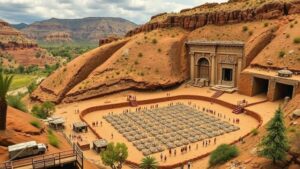Techniques for Detecting Rich Ore Deposits Using Agricola’s Geological Principles
Techniques for Detecting Rich Ore Deposits Using Agricola’s Geological Principles
Throughout history, mining has been an essential component of economic development, and understanding the science behind detecting rich ore deposits has remained crucial. Georgius Agricola, often referred to as the father of mineralogy, laid the groundwork for several geological principles that can be applied to modern mining techniques. This article explores key methods for detecting ore deposits, supported by Agricola’s teachings.
Understanding Agricolas Contributions
Agricolas seminal work, De re Metallica, published in 1556, provided detailed descriptions of mining and metal extraction processes. He emphasized the importance of geology in the exploration of mineral deposits. His principles can be distilled into various techniques that remain relevant today:
- Study of Surface Geology
- Use of Color and Texture Analysis
- Examination of Mineral Associations
Study of Surface Geology
One of Agricola’s main insights was the significance of surface geology in locating ore deposits. Observing rock formations, soil types, and vegetation can indicate the presence of underlying minerals. This approach involves:
- Outcrop Mapping: Detailed mapping of exposed rock formations helps identify the stratigraphic layers that may contain valuable minerals.
- Geological Surveys: Systematic surveys utilizing techniques such as aerial photography and satellite imaging can reveal patterns indicative of mineral deposits.
Case studies have illustrated the effectiveness of these methods. For example, in the Canadian Shield region, geologists have successfully located gold and other precious metals by mapping the surface geology in conjunction with historical mining data.
Use of Color and Texture Analysis
Agricola also highlighted the importance of visual cues in detecting minerals. The color and texture of rocks can provide preliminary information about their composition. Techniques employed include:
- Petrographic Analysis: Utilizing thin sections of rock under a microscope allows geologists to observe mineral characteristics and relationships.
- Field Tests: Simple field tests, such as streak testing and acid testing, can determine mineral identities based on their reaction to certain chemicals and their streak color.
Real-world applications of these techniques can be seen in the mining operations in Nevada, where geologists have identified rich silver deposits by analyzing the unique color patterns and textures of surrounding rock formations.
Examination of Mineral Associations
Another fundamental concept presented by Agricola is the significance of mineral associations. Certain minerals frequently occur with others, indicating the potential presence of economically viable deposits. Notable points to consider are:
- Indicator Minerals: The presence of specific minerals, such as garnet, may indicate proximity to diamond deposits.
- Geochemical Surveys: Collecting soil and rock samples for geochemical analysis allows for the detection of trace elements associated with primary minerals, providing a broader picture of potential deposits.
For example, exploration companies successfully utilized geochemical surveys in Brazil to locate high-concentration bauxite deposits by focusing on aluminum-rich minerals.
Concluding Thoughts
Utilizing Agricola’s geological principles, modern techniques for detecting rich ore deposits blend historical wisdom with innovative practices. By studying surface geology, interpreting color and texture, and examining mineral associations, contemporary mining efforts can be significantly enhanced. As exploration continues to evolve, integrating traditional methods with modern technology promises to yield even greater discoveries of valuable mineral resources.
In summary, the techniques discussed offer actionable takeaways for both mining professionals and academic researchers:
- Conduct thorough geological surveys to inform exploration decisions.
- Employ petrographic and field tests to obtain accurate mineral identifications.
- Use geochemical analyses to reveal hidden mineral associations.



